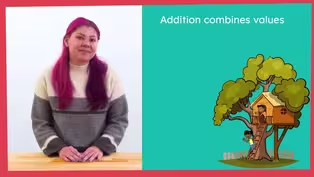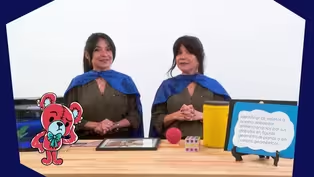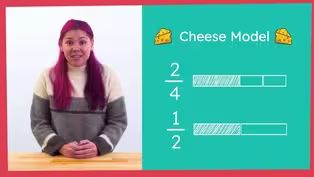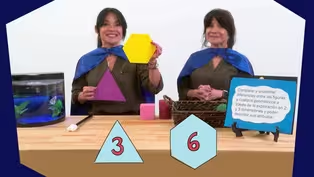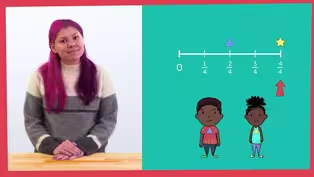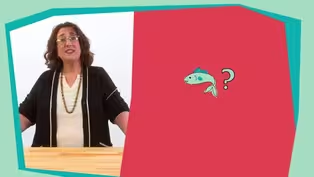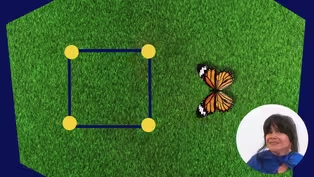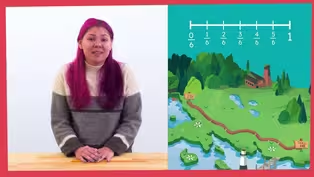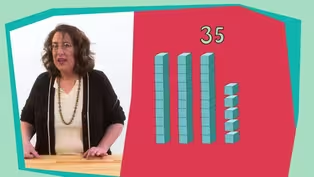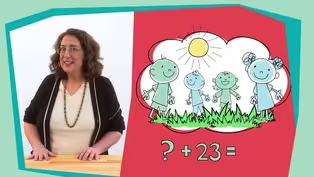
Episode 42 | Math Lessons
5/10/2021 | 28m 46sVideo has Closed Captions
Math lessons for early learners, led by NC teachers.
The first lesson (aimed at 3rd graders) teaches students about the multiplication strategy of “doubles.” The second lesson (aimed at PreK-K) teaches students how to count groups of numbers. Classroom Connection is your At-Home Learning companion where children love to learn. All lessons are led by NC educators.
Problems playing video? | Closed Captioning Feedback
Problems playing video? | Closed Captioning Feedback
At-Home Learning Presents: Classroom Connection is a local public television program presented by PBS NC

Episode 42 | Math Lessons
5/10/2021 | 28m 46sVideo has Closed Captions
The first lesson (aimed at 3rd graders) teaches students about the multiplication strategy of “doubles.” The second lesson (aimed at PreK-K) teaches students how to count groups of numbers. Classroom Connection is your At-Home Learning companion where children love to learn. All lessons are led by NC educators.
Problems playing video? | Closed Captioning Feedback
How to Watch At-Home Learning Presents: Classroom Connection
At-Home Learning Presents: Classroom Connection is available to stream on pbs.org and the free PBS App, available on iPhone, Apple TV, Android TV, Android smartphones, Amazon Fire TV, Amazon Fire Tablet, Roku, Samsung Smart TV, and Vizio.
Providing Support for PBS.org
Learn Moreabout PBS online sponsorshipMore from This Collection
Video has Closed Captions
Math lessons for early learners, led by NC teachers. (28m 46s)
Video has Closed Captions
Math lessons for early learners, led by NC teachers. (28m 46s)
Video has Closed Captions
Math lessons for early learners, led by NC teachers. (28m 46s)
Video has Closed Captions
Math lessons for early learners, led by NC teachers. (28m 46s)
Video has Closed Captions
Math lessons for early learners, led by NC teachers. (28m 46s)
Video has Closed Captions
Math lessons for early learners, led by NC teachers. (28m 46s)
Video has Closed Captions
Math lessons for early learners, led by NC teachers. (28m 46s)
Video has Closed Captions
Math lessons for early learners, led by NC teachers. (28m 46s)
Video has Closed Captions
Math lessons for early learners, led by NC teachers. (28m 45s)
Video has Closed Captions
Math lessons for early learners, led by NC teachers. (28m 46s)
Video has Closed Captions
Math lessons for early learners, led by NC teachers. (28m 45s)
Video has Closed Captions
Math lessons for early learners, led by NC teachers. (28m 46s)
Providing Support for PBS.org
Learn Moreabout PBS online sponsorship[cheerful upbeat music] ♪ - This is wild.
Listen to this.
From zero to 1000, the only number that has the letter A in it is 1000!
That's like a math fact and a reading fact.
Do you get extra credit for learning these amazing facts?
I'm just joking, but we're getting started with today's math lesson right now so don't go anywhere!
- Hi, mathematicians!
It's me, Ms. Altman, and it's amazing to see you!
Before we get started, let's take 20 seconds to grab some supplies that we will need for our time together today.
You will need paper and a pencil.
I'm going to go and get mine.
Why don't you go ahead and do the same?
See you in a little bit!
[bright music] Today we're going to learn a new multiplication strategy that involves doubles!
Do you remember what a double is?
It's probably a word that you have heard or a strategy that you have used before.
A double is when you add the same number to itself.
For example, you may have learned strategies such as adding doubles like 3 plus 3, 5 plus 5, or 2 plus 2.
Let's take a closer look at some doubles.
Let's look at 3 plus 3 again.
What do you notice?
What do you wonder?
Share your thinking with a trusted adult or a friend.
Can I share with you what I noticed?
Great!
I noticed that I have two groups of the same thing.
I have two groups, with three basketballs in each group.
As a reminder, a double is when you add the same number to itself, like 3 plus 3.
Keeping this in mind, I wonder if we can write this information in a different way.
You know, use something besides an addition fact.
What's that?
Yes, that's a great idea!
We can use a multiplication equation.
Oh my goodness.
Kiss your brain and blow it out of this world.
[lips smacking] Pow.
That's some excellent thinking!
As a third grader, you are learning multiplication.
So instead of thinking of doubling as adding the same number to itself, we can also say that doubling means that we are multiplying a number by two.
Here's a visual to help us.
Instead of saying 3 plus 3, we could say we have two groups of three or 2 times 3.
I like to think of doubles as old friends because it's a strategy I've taught in first grade and continue to use with all grades, especially third grade.
And once you learn to double, you can double that double and double that double you just doubled, or double double!
Oh my goodness!
[claps] That's a lot of doubles.
So are you ready to learn the doubling strategy?
Great!
Today we will learn a strategy for multiplying twos, fours, and eights using the idea of doubling.
As the reminder, factors are the numbers being multiplied and a product is a result of multiplying factors.
Don't forget to use your math vocabulary for today: doubles, doubling, factors, and product.
Let's look at some examples.
What do you notice about the following multiplication sentences?
2 times 2, 2 times 4, 2 times 8.
Look carefully at the factors in each multiplication equation and then the product.
I will give you a few seconds to solve each multiplication sentence.
[gentle music] Okay, let's look at the product of each multiplication sentence.
2 times 2 is 4.
2 times 4 is 8.
2 times 8 is 16.
I'm going to give you a few seconds to look at these equation again.
As you look at these equations, what do you notice about the factors and the product?
Oh that's great thinking, mathematicians.
Do you mind if I share what you notice with everyone?
Great!
You noticed that in each equation, the first factor is two.
So you can multiply the other factor by two or simply double it.
2 times 2 is the same as two doubled or 2 plus 2.
2 times 4 is the same as four doubled or 4 plus 4.
And 2 times 8 is the same as eight doubled or 8 plus 8.
Awesome!
And what did you notice about the product?
That's right!
You noticed that the products are doubles of the previous multiplication sentence's product.
Two doubled is four, four doubled is eight, and eight doubled is 16.
Just in case you didn't notice the products doubling, here's some visuals to help you.
Let's start with two basketballs because that's the factor we are multiplying.
Two doubled is four.
Four doubled is eight.
And eight doubled is 16.
And oh wow, I noticed something else!
Check this out.
I'm going to change the factors where two would be the second factor instead of the first.
Instead of 2 times 4, look at 4 times 2.
What would happen if we multiply 4 times 2?
That's right.
We would have the same product.
Changing the order of the factors does not change the product.
We still have eight basketballs.
When we multiply 4 times 2, it is the same as doubling two twice.
This strategy is called double double or doubling twice.
What is two doubled?
That's right, four.
What is four doubled?
Right again!
It's eight!
To summarize, when we multiply by two, we can just double the other factor.
And when we multiply by four, we can double the other factor twice.
Let's try another example.
Are you ready?
Let's solve 4 times 3.
Remember, when we multiply by four, we can use the double double strategy by doubling the factor we are multiplying by four twice.
In the problem 4 times 3, we will double the number three twice.
What is three doubled?
Excellent thinking.
Three doubled is six.
What is six doubled?
Correct!
It's 12.
So 4 times 3 is 12.
Would you like to try this strategy again?
Great!
Let's try the double double or doubling twice strategy without visuals.
Ooh.
What is 7 times 4?
Remember, double the other factor we are multiplying by four twice.
So what is the other factor?
Yes, it's seven.
What is seven doubled?
14.
What is 14 doubled?
28.
You're doing a tremendous job using this strategy.
I think you're ready to learn another doubling strategy.
There's one more strategy we can learn that uses doubling.
Look at 2 times 8 again.
What happened when we multiply 2 times 8?
That's right.
We doubled the eight twice.
Now let's look at 8 times 2.
Remember, we are trying out the double double double strategy or doubling three times.
Which factor should we double three times?
Yes, you've got it.
When multiplying by eight, we double the other factor three times.
So let's double the two in 8 times 2.
What is two doubled?
Four.
What is four doubled?
Eight.
What is eight doubled?
16.
Double, double, double.
Wow!
Let's try another problem.
8 times 3.
What is three doubled?
Six.
What is six doubled?
12.
What is 12 doubled?
24.
Excellent job, everyone.
Thanks for joining me today.
I hope you had fun learning a new strategy for multiplying twos, fours, and eights using the doubling strategy.
To use the doubling strategy, please remember the following: double the other factor once for multiplying by twos, double twice for multiplying by fours, and double three times for multiplying by eights.
Using the doubling strategy can help you become fluent for multiplying within 100.
Join me next time to learn more math strategies.
Bye, mathematicians!
[air whooshes] - All right, folks.
I'm so full of letters and numbers.
Feels good to know so much, doesn't it?
Let's take a break from our lesson and check out this cool video.
- Hi, kids.
Welcome to another episode of "Paint N Sippy Cup."
I'm your host, Auntie Gem, and today I am sipping on cranberry juice.
So I'm just gonna pour some in my cup.
[relaxing ambient music] Today's episode, we are gonna be painting one of my favorite animals: a cat.
And not just any kind of cat, but a purple cat.
You can make your cat whatever color you want.
I'm going to draw the cat first on our canvas.
If you don't have canvas, you can just use paper or a cardboard.
So, I'm gonna start with my background first.
Your background can be a different color.
You can use blue, you can use orange, you can use green, you can use yellow, whatever color calls out to you.
If you don't have an easel like I do, which is holding my painting up, feel free to paint flat on your table but make sure you put some newspaper or plastic underneath so that you don't get paint everywhere.
Don't forget to sip your juice.
So I'm still waiting on my cat to dry before I add some more layers to it.
So I'm gonna go back into the background now that this is dry so that I can make that pink even brighter.
All right, now that I have my second layer of my cat, I can go back and finally fill in my outline.
You can add all types of things in the background.
If you want a sun in the background, please add that.
If you want glitter in the background, please add that.
If you want polka dots in the background, words, do whatever feels good for you.
Make your art represent who you are.
I wanna thank you for joining me on this episode of "Paint N Sippy Cup," where today we painted this cat.
I look forward to seeing what you create.
Keep creating all the time, and I'll see you next time.
- Wow.
I hope you liked that as much as I did.
What was your favorite part?
Let's not stop the party now 'cause I'm ready to learn some more.
[chill music] - Hello, super learners.
Ms. M here.
I am so glad that you are here today.
Are you ready for another math adventure today?
Well, let's get started.
♪ Hello, super learners ♪ ♪ How are you ♪ ♪ Hello, super learners ♪ ♪ How are you ♪ ♪ I'm so glad you're here today ♪ ♪ And I hope you feel the same ♪ ♪ Hello, super learners ♪ ♪ How are you ♪ How are you today, super learners?
I feel star-tastic today!
And I hope you do too.
Let's get started with our math power warmups, counting up to 20.
Are you ready?
Here we go.
♪ One, two, three, four ♪ ♪ Five, six, seven ♪ ♪ Eight, nine, 10 ♪ ♪ 11, 12 ♪ ♪ 13, 14, 15 ♪ ♪ 16, 17, 18 ♪ ♪ 19, 20 ♪ ♪ That was fun ♪ Well, now it's time to snap count up to 20.
[snapping] Ready?
Let's go.
One [snaps], two [snaps], three [snapping], four [snaps], five [snaps], six [snapping], seven [snaps], eight [snaps], nine [snapping], 10 [snaps], let's keep going, 11 [snaps], 12 [snaps], 13 [snapping], 14 [snaps], 15 [snaps], 16 [snapping], 17 [snaps], 18 [snaps], 19 [snapping], 20 [snaps], yes, super learners are the best.
I'm feeling all warmed up and I hope you are too.
One more time counting, but this time in Spanish.
[speaking in Spanish] Amazing, amazing, super learners.
Now it's time to review our colors, in English and Spanish.
[speaking in Spanish] Red, [speaking in Spanish] orange, [speaking in Spanish] yellow, [speaking in Spanish] green, [speaking in Spanish] blue, [speaking in Spanish] purple, [speaking in Spanish] brown, [speaking in Spanish] black, [speaking in Spanish] white, [speaking in Spanish] gray.
Look for these colors in the world today.
And now for our last math power warmup, time for the shape game.
You will see a shape, and then you say its name in English or Spanish.
[speaking in Spanish] Square, [speaking in Spanish] circle, [speaking in Spanish] triangle, [speaking in Spanish] rectangle, [speaking in Spanish] rhombus, [speaking in Spanish] trapezoid, [speaking in Spanish] hexagon, [speaking in Spanish] cube, [speaking in Spanish] cone, [speaking in Spanish] cylinder, [speaking in Spanish] sphere.
Math-tastic!
I hope you are all warmed up because it's time for... [hands slapping] ♪ Our math mission of the day ♪ Come on, let's check in with Sparkles the Fish to see what our mission is today.
Hello, Sparkles.
Thank you, Sparkles.
Here it is!
Dear super learners.
Your mission today is to count to know the total number of objects.
There are two different mini missions today, where there are certain number of objects needed.
Count to find the right group of objects for each mini mission.
Well, super learners, a total is an amount or number of something.
For example, I have one, two, three, four, five, five fingers on my hand.
Each finger is only one, but altogether, I have five in total.
So today, we will count different groups of objects to find the ones that have the totals that we need.
Super learners, I know we can do this mission.
[gentle music] Capes on!
Math power up!
Let's go.
Hey, here are two different cups of [gasps] hot chocolate!
Yum!
With mini marshmallows!
And look.
Here is our first mini mission.
A friend loves to put seven mini marshmallows in their hot chocolate.
Which cup of hot chocolate should they drink?
Cup A or cup B?
What do you think?
All right, super learners.
Let's count the two groups to see which cup has the marshmallows we need.
When we count the marshmallows, we can only count each one once in order to know the right total.
Ready?
Let's count.
Math power up!
Let's count cup A.
One, two, three, four, five, six, seven, eight, nine, 10.
This cup has 10 marshmallows.
You see the number 10 above the cup?
That's so we can remember the total.
Well now let's count the other cup.
One, two, three, four, five, six, seven.
This cup has seven marshmallows in total.
So which cup should the friend drink?
Yes, super learners, cup B!
There are seven marshmallows in cup B. Amazing job, super learners.
We completed our first mini mission.
One more to go.
We can do it, super learners, but before we do, let's play our math moves game.
I will pull out two cards.
You'll see them on the screen.
Each round, one will tell us a move and the other will be a number card, which will tell us how many to do.
Ready to play?
Math power up.
Ooh, nine leg lifts.
One, two, three, four, five, six, seven, eight, nine.
Eight raise the roofs.
One, two, three, four, five, six, seven, eight.
10 skips in place.
One, two, three, four, five, six, seven, eight, nine, 10.
[gasps] Two big knee bends.
One, two.
Four jumps.
One, two, three, four.
Great job, super learners.
I think we are ready for our next mini mission.
Wow!
Look at these two shirts.
I wonder what our mini math mission is.
Oh!
Look!
Here it is.
It says a friend wants to wear a shirt with nine hearts on it.
Which shirt should they choose?
Shirt A or shirt B?
What do you think?
Well, super learners, we know what to do.
Let's count.
Math power up.
Let's count the hearts on shirt A first.
One, two, three, four, five, six, seven, eight, nine.
There are nine hearts on shirt A.
You will see a nine above the shirt so that we remember the total.
Ready?
Let's count the hearts on shirt B.
One, two, three, four, five, six.
There are six hearts on this shirt.
You'll see that number six so that we can remember the total.
Okay, super learners.
We have counted the hearts on both shirts.
Which shirt should the friend choose?
I'm listening!
[gasps] Yes!
Shirt A has nine hearts.
We did it, super learners.
We counted the hearts and found the right shirt.
Hey.
In fact, we counted and found the right cup of hot chocolate too.
Let's check back with Sparkles the Fish.
[soft music] [gasps] Mission complete.
[air whooshes] Thank you, Sparkles.
Congratulations, super learners!
You used your math powers and completed the mission.
What is it time to do?
Let's review.
We can count objects by counting each one one at a time.
Remember to count each object only once in order to get the right total or amount.
Touching or marking each object as we count helps us to count accurately or the correct amount.
Practice counting today, super learners.
You can share your math power by showing it to someone.
Thank you, super learners, for going on a math mission with me today.
Sparkles thanks you too.
Remember, you have the power to be super at math.
Bye!
Adios!
Math power out.
- Hey, everyone.
It's your boy Jose here.
And today we're gonna be covering another hip hop step.
Today's move is called the wave, okay.
And we're gonna start off with our hands up, just like this, okay?
So you start and finish at your fingertips.
So starting off on this end, we're gonna cover it at the fingers first.
Bend your fingers on the one, good, nice work.
Knuckles, straighten your fingers out, and just bend at the knuckles.
Good job.
Just like this.
Take your time, don't rush it.
Go to the wrist.
This is three.
Nice work, nice work.
Straighten your whole fingers out and the hand out.
Good job.
Next, bend your elbow upward.
Nice.
That's four.
Bring it up to the shoulder as you straighten your arm out.
That's five.
Good work.
Switch it to the other side.
Six.
Nice.
Now bring it to the elbow.
Seven.
Great job.
Now straighten it out to the wrist.
Eight.
Keep going.
To the knuckles.
Nine.
Bend the fingers is going to be 10.
Good work.
And then finally, you just let it out on your left.
Nice.
You can not do it slow, you cannot do it fast, sorry, if you cannot do it slow, So try it from one side to the other.
One, two, three, four, five, six, seven, eight, nine, 10, 11, out.
When you put it all together, that should look like this.
[chill hip hop music] Same thing on the other side.
[chuckles] Good job.
Good job.
So make sure everyone goes home.
Well, you are home, so make sure that everyone is practicing, practicing, practicing, and I'll catch you guys on the next one, peace.
- Wow.
Time sure does fly when you're learning and having fun.
I wanna thank you so much for joining us today on PBS North Carolina.
You are so smart, so special, and so fun to be with.
Wishing you peace, love, and learning, my friends.
[cheerful upbeat music] ♪
Support for PBS provided by:
At-Home Learning Presents: Classroom Connection is a local public television program presented by PBS NC
